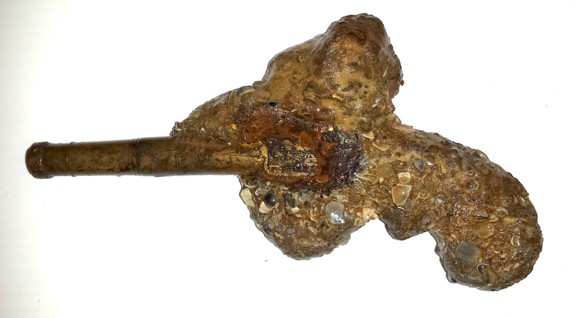New discoveries are made at the lighthouse every day in our maritime research conservation lab. As we continue to clean and prepare artifacts from a 1782 British Loyalist wreck found just off St. Augustine’s coast for an upcoming exhibit, we are learning more about the wreck and the people who were on board this vessel.
In 2010, we recovered a concretion from the “Storm Wreck” that contained a pistol.
From the initial X-ray we learned that this pistol was a Queen Anne style box-lock pocket pistol, meaning that instead of the more commonly thought of side-lock pistols, our gun has its hammer in line with the barrel. This is how most modern day guns are made.
Also from this X-ray, we learned that the barrel was made of brass, with the hammer, trigger, and trigger guard all being made of iron.
Using X-rays to Form a Conservation Strategy
Newer X-rays, taken after the pistol was removed from the rest of the concretion, revealed more information about the handle and the internal mechanisms. The new X-rays show us the shape of the hammer as well as the presence of the flint.
Also unseen before are the mainspring and elaborate decorations on the handle.

Pistol X-rays showing the shape of the hammer with intact flint, mainspring, and handle decorations.
Those X-rays gave us a good “road map” so we could create a plan for removing concretions from the rest of the pistol. Some of the dark portions within the X-ray indicate cavities where metal used to exist (for example the trigger guard and trigger plate).
These cavities will have to be filled with a casting material so we can get a replica of what used to be there. The bright areas are examples of metals fairly well preserved. The barrel is in particularly good condition, and we have been able to start uncovering it.
Maker’s Mark
Upon uncovering the barrel, we discovered proof marks and engravings giving us the location and manufacturer of this particular pistol.
The location is London, and the manufacturer is Ketland. Since the whole inscription has not yet been uncovered, we cannot yet know if it just says Ketland or Ketland & Co like in the example shown in the upper right corner.

Top shows examples of engravings done on a Ketland & Co. manufactured pistol of the same style as ours. The bottom shows what we have uncovered on our pistol so far.
The proof marks are much harder to see, but they confirm London manufacture, and possibly that the maker was Thomas Ketland, the original gun maker under this name. Thomas Ketland started producing guns in 1760, and exporting them by 1790. He died in 1816.

Proof marks found on the underneath side of the barrel. The top mark shows a crown with a P under it and is a true proof mark. The bottom is much harder to see and appears to be a symbol with TK under it.
Check back later to find out what else we discover as we work to conserve this pistol.
Click here to read more stories about artifacts under conservation at our museum!
Starr Cox, Director of Archaeological Conservation, joined the St. Augustine Lighthouse & Maritime Museum research team in March 2010. A native of Kansas City, she holds a bachelor’s in anthropology and archaeology from the University of Kansas and a master’s in nautical archaeology, as well as certificates in historical preservation and archaeological conservation, from Texas A&M University.



